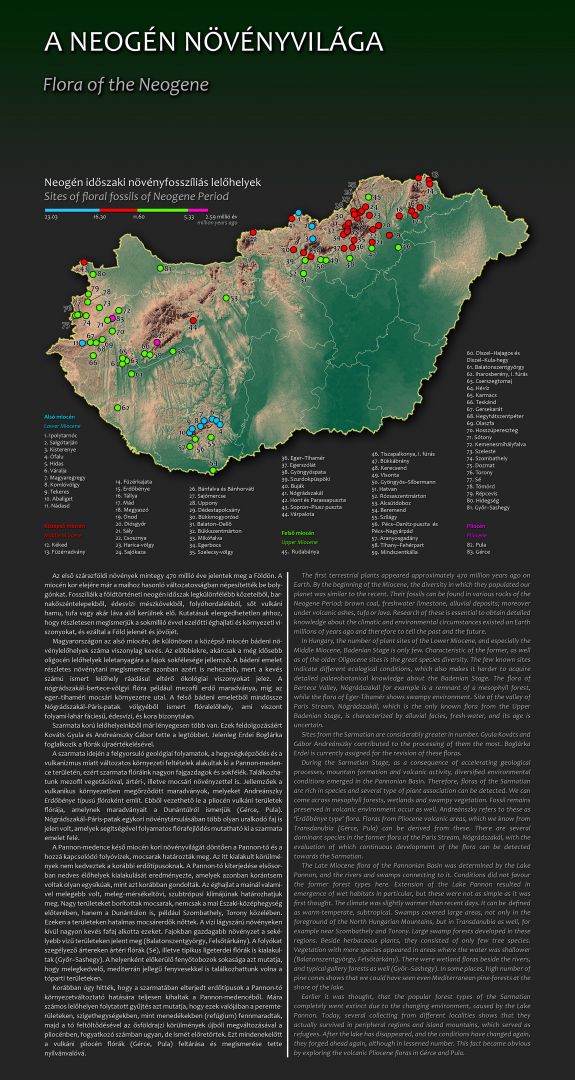MIOCENE FAUNA - 2. view
Flora of the Neogene
The first terrestrial plants appeared approximately 470 million years ago on Earth. By the beginning of the Miocene, the diversity in which they populated our planet was similar to the recent. Their fossils can be found in various rocks of the Neogene Period: brown coal, freshwater limestone, alluvial deposits; moreover under volcanic ashes, tufa or lava. Research of these is essential to obtain detailed knowledge about the climatic and environmental circumstances existed on Earth millions of years ago and therefore to tell the past and the future.
In Hungary, the number of plant sites of the Lower Miocene, and especially the Middle Miocene, Badenian Stage is only few. Characteristic of the former, as well as of the older Oligocene sites is the great species diversity. The few known sites indicate different ecological conditions, which also makes it harder to acquire detailed palaeobotanical knowledge about the Badenian Stage. The flora of Bertece Valley, Nógrádszakál for example is a remnant of a mesophyll forest, while the flora of Eger-Tihamér shows swampy environment. Site of the valley of Paris Stream, Nógrádszakál, which is the only known flora from the Upper Badenian Stage, is characterized by alluvial facies, fresh-water, and its age is uncertain.
Sites from the Sarmatian are considerably greater in number. Gyula Kováts and Gábor Andreánszky contributed to the processing of them the most. Boglárka Erdei is currently assigned for the revision of these floras.
During the Sarmatian Stage, as a consequence of accelerating geological processes, mountain formation and volcanic activity, diversified environmental conditions emerged in the Pannonian Basin. Therefore, floras of the Sarmatian are rich in species and several type of plant association can be detected. We can come across mesophyll forests, wetlands and swampy vegetation. Fossil remains preserved in volcanic environment occur as well. Andreánszky refers to these as ‘Erdőbénye type’ flora. Floras from Pliocene volcanic areas, which we know from Transdanubia (Gérce, Pula) can be derived from these. There are several dominant species in the former flora of the Paris Stream, Nógrádszakál, with the evaluation of which continuous development of the flora can be detected towards the Sarmatian.
The Late Miocene flora of the Pannonian Basin was determined by the Lake Pannon, and the rivers and swamps connecting to it. Conditions did not favour the former forest types here. Extension of the Lake Pannon resulted in emergence of wet habitats in particular, but these were not as simple as it was first thought. The climate was slightly warmer than recent days. It can be defined as warm-temperate, subtropical. Swamps covered large areas, not only in the foreground of the North Hungarian Mountains, but in Transdanubia as well, for example near Szombathely and Torony. Large swamp forests developed in these regions. Beside herbaceous plants, they consisted of only few tree species. Vegetation with more species appeared in areas where the water was shallower (Balatonszentgyörgy, Felsőtárkány). There were wetland floras beside the rivers, and typical gallery forests as well (Győr–Sashegy). In some places, high number of pine cones shows that we could have seen even Mediterranean pine-forests at the shore of the lake.
Earlier it was thought, that the popular forest types of the Sarmatian completely went extinct due to the changing environment, caused by the Lake Pannon. Today, several collecting from different localities shows that they actually survived in peripheral regions and island mountains, which served as refugees. After the lake has disappeared, and the conditions have changed again, they forged ahead again, although in lessened number. This fact became obvious by exploring the volcanic Pliocene floras in Gérce and Pula.
